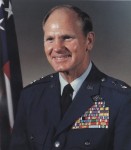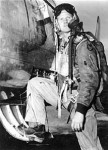Major General “Boots” Blesse, a double ace with two combat tours each in Korea and Vietnam, is the sixth-ranking U.S. jet ace and one of the world’s  premier jet tacticians. Born in the Panama Canal Zone in 1921, he graduated from West Point in 1945 and was commissioned a second lieutenant in the U.S. Army Air Force. He flew numerous aircraft prior to his transition into the North American F-86 Sabre. With the outbreak of the Korean War, Blesse volunteered for combat even though it meant leaving the F-86 for the prop-driven North American P-51 Mustang.
premier jet tacticians. Born in the Panama Canal Zone in 1921, he graduated from West Point in 1945 and was commissioned a second lieutenant in the U.S. Army Air Force. He flew numerous aircraft prior to his transition into the North American F-86 Sabre. With the outbreak of the Korean War, Blesse volunteered for combat even though it meant leaving the F-86 for the prop-driven North American P-51 Mustang.
He flew 67 air-to-ground combat missions in the Mustang and 35 additional missions in the Lockheed F-80 Shooting Star before being assigned to George AFB, California. He immediately volunteered for a second combat tour, flying the F-86 in the air-to-air role. In the spring of 1952, Blesse became operations officer of the 334th Tactical Fighter Squadron. His guidance was simple–get MiGs! And under his aggressive leadership, the victory tally for the squadron grew steadily. By September, Blesse claimed his fifth aerial victory, making him the nineteenth ace of the Korean Conflict. Within the next month, he ran his total score to 10, including 9 MiG-15s and a La-9, becoming America’s leading jet ace at the time.
 After returning to the U.S. in October 1952, he documented the lessons of air-to-air combat in No Guts, No Glory, a manual used for over 20 years as the authoritative guidance on how to train for and fly in combat. Blesse’s superior flying skills were later evidenced when he flew the F-86F as a member of the Air Training Command team at the 1955 USAF Worldwide Fighter Gunnery Meet. He won all six trophies awarded for individual performance, a feat that has never been equaled. He again volunteered for combat in 1967 and was assigned as the Director of Operations, 366th Tactical Fighter Wing, Da Nang Air Base, Vietnam. In this capacity, Blesse flew 108 combat missions over North Vietnam and another 46 sorties in Laos and South Vietnam in the McDonnell Douglas F-4 Phantom II.
After returning to the U.S. in October 1952, he documented the lessons of air-to-air combat in No Guts, No Glory, a manual used for over 20 years as the authoritative guidance on how to train for and fly in combat. Blesse’s superior flying skills were later evidenced when he flew the F-86F as a member of the Air Training Command team at the 1955 USAF Worldwide Fighter Gunnery Meet. He won all six trophies awarded for individual performance, a feat that has never been equaled. He again volunteered for combat in 1967 and was assigned as the Director of Operations, 366th Tactical Fighter Wing, Da Nang Air Base, Vietnam. In this capacity, Blesse flew 108 combat missions over North Vietnam and another 46 sorties in Laos and South Vietnam in the McDonnell Douglas F-4 Phantom II.
He was instrumental in the development and testing of the SUU-16 gun pod, used throughout the war on the F-4C, and was a major influence in the decision to include an internal gun in later versions of the F-4. He then commanded the USAF’s first wing of General Dynamics F-111 Aardvarks, and, returning to Vietnam, served as Assistant Director of Operations for Seventh Air Force. Prior to his retirement as a major general in 1975, Blesse was the Deputy Inspector General of the Air Force. A command pilot with over 6,500 flying hours, Blesse is retired from the Grumman Corporation and lives with his wife, Betty, in Florida.
